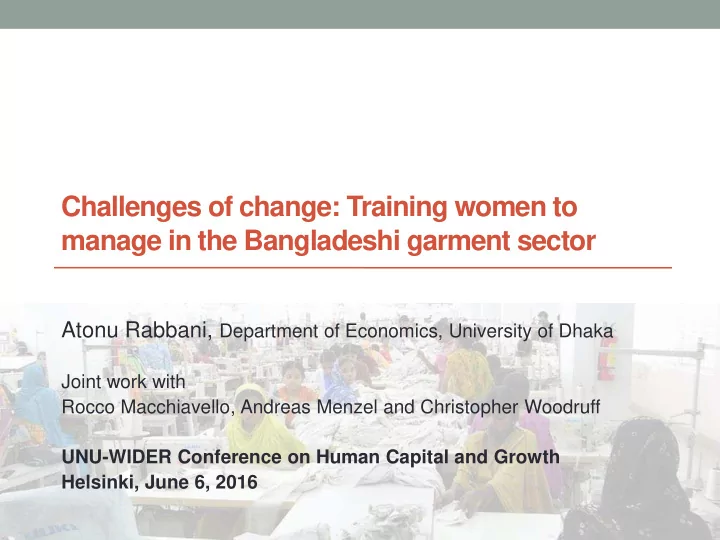

Challenges of change: Training women to manage in the Bangladeshi garment sector Atonu Rabbani, Department of Economics, University of Dhaka Joint work with Rocco Macchiavello, Andreas Menzel and Christopher Woodruff UNU-WIDER Conference on Human Capital and Growth Helsinki, June 6, 2016
Managing people ably is important
1 Management is important 0.9 Proportion of Firms below Global 0.8 Data suggests a long tail of “bad” 0.7 firms at the left tail of the distribution in 0.6 the developing Median countries. 0.5 one quarter of 0.4 cross-country 0.3 productivity differences can be 0.2 explained by differences in y = -0.1753x + 2.287 0.1 management R² = 0.7647 practices. 0 - Bloom , Sadun 7 8 9 10 11 12 and Van Reenen (2015) Log (GDP per employed Labor)
75 th percentile line is more than 1.5 times more productive compared to the 25 th percentile line! Moreover… There is a huge potential to gain in terms of productivity within firms as well. Note: Based on 42,000 line-days worth of data from 7 factories. Source: Machiavello, Rabbani and Woodruff (2015)
Context and Questions
Addressing some of these issues at RMG Sector in Bangladesh • Very large: about 4m people involved in the sector • Moreover, 65% is female • At the sewing lines: 70-80% • However, less than 5% of the supervisors are women • Why? • Marginal female supervisor is worse than male supervisor • OR, NOT, suggesting managerial talent is misallocated • Worse or not, women are perceived as being worse in supervisory roles • Not trying them as supervisors can contribute to persistence in such perceptions
Design
Design and Data Collection • Just observational data will not be useful: too few women supervisors and endogenous assignments • So we work with 24 suppliers of a single large foreign buyer • Factories nominated operators for a GIZ-designed six- week offsite training on production, quality and HR/compliance • Factories selected 96 men and 121 women for training – 72 men and 73 women finally completed the training
Randomization • Factories were randomly allocated into either rounds 1 and 3 or rounds 2 and 4 • Trainees from each factory were randomized either 1 or 3 and similarly either 2 or 4 • Then trainees were randomly assigned among the trial lines • We collected data… • …before the trainings started ( Findings 1 and 2): skill assessments, perceptions • …right after the six -eight week of trials and a further two-four month follow-ups (Findings 3): production data • …further follow -ups (Findings 4 ): “production management” games
Findings
Finding #1 • In broadly defined eight sets of tasks, women are perceived as weaker supervisors • Consistent across the whole managerial hierarchy, including the operators • Women are considered less able to understand machines and operations • These perceptions are slightly weaker among the female operators and those who have worked under female supervisors
Perceived Ability HR Managers Production Managers Line Chiefs Line Supervisors Line Operators by Gender in 0.40 Supervisory Roles 0.20 0.00 Negative means men are perceived -0.20 as better supervisors -0.40 -0.60 Most people think -0.80 so. -1.00 And across almost all tasks.
Female Operators Male Operators LO's worked w/ female SV Female trainees Male trainees 0.20 Perceived Ability cont. 0.00 Female trainees have -0.20 more favorable views followed by female -0.40 operators. -0.60 Average male operators have the -0.80 least favorable views. -1.00 Exposure to female supervisors mitigate some of the bias.
Finding #2 • Before the training, using extensive skill assessments, we find • Female and male trainees have similar technical knowledge of machines and operations contrary to widely-held beliefs • However, women are chosen less in simulated management games • Women themselves rate themselves lower in the same eight broad sets of tasks
1.19 Based on extensive skill assessments 0.22 Not much statistical differences -0.09 -0.27 -0.47 Female trainees -0.6 lack confidence Aptitude score Percentage drawings Drawing, "soft" score Communication, "soft" Leadership, "soft" score Self confidence* (which disappears after the training) correct score
Finding #3 • Using detailed line level productivity data, we look at efficiency, quality defects and absenteeism • Immediately after the training, initially the female supervisor perform worse • This gap disappears after few months at the line
Finding #3 Efficiency Defects 0.0236 0.0196 0.0176 -0.0013 -0.002 -0.0042 -0.0093 -0.0055 Female trainee Male trainee Female Male trainee Female trainee Male trainee** Female trainee Male trainee trainee* Trial period Post-trial Trial period Post-trial
Finding #4 • The experiment also allows us to understand change in attitude towards female line supervisor • Female trainees are ranked almost a point lower • Male operators rank the female trainees lower than female operators (-1.39 as oppose to -0.65) • Male operators also hold more pessimistic view toward prospect of promotion to supervisory roles in future and report leaving the factory sooner • In simulated management exercises, the female trainees outperform the male counterparts (by 0.29 SD higher payoffs), but NOT when a male operator is in the group • The promoted trainees do even better • Female leaders are ranked lower and less able to identify the “correct” strategies
Conclusions
Some parting remarks • Women are expected to be worse in supervisory positions in any number of tasks, while evidence suggests otherwise • Signaling may be difficult as women are not tried in supervisory positions • Factories may tend to internalize the perception and the attitudes, rendering changing the equilibrium challenging
Thanks for listening
Recommend
More recommend